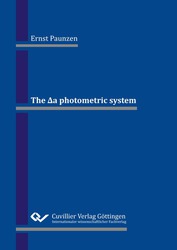| Areas | |
|---|---|
| Serie de libros (96) |
1378
|
| Nachhaltigkeit |
3
|
| Gesundheitswesen |
1
|
| Letra |
2364
|
| Ciencias Naturales |
5406
|
| Matemática | 229 |
| Informática | 319 |
| Física | 980 |
| Química | 1363 |
| Geociencias | 131 |
| Medicina humana | 243 |
| Estomatología | 10 |
| Veterinaria | 108 |
| Farmacia | 147 |
| Biología | 835 |
| Bioquímica, biología molecular, tecnología genética | 121 |
| Biofísica | 25 |
| Nutrición | 45 |
| Agricultura | 1004 |
| Silvicultura | 201 |
| Horticultura | 20 |
| Ecología y conservación de la tierra | 148 |
| Ciencias Ingeniería |
1793
|
| General |
98
|
|
Leitlinien Unfallchirurgie
5. Auflage bestellen |
|
Erweiterte Suche
The ∆a photometric system (Tienda española)
Ernst Paunzen (Autor)Previo
Lectura de prueba, PDF (320 KB)
Indice, PDF (54 KB)
This book describes the characteristics and applications of the Δa photometric system, which measures the stellar flux at around 520 nm.
Since its introduction in 1976 by Hans-Michael Maitzen, the Δa system has not only been successfully applied to the classical chemically peculiar stars of the upper main sequence, but also to galactic and extragalactic star clusters. New possible applications for studying galaxies, quasars and other astrophysical objects of interest are discussed.
| ISBN-13 (Impresion) | 9783736972834 |
| ISBN-13 (E-Book) | 9783736962835 |
| Formato | A5 |
| Idioma | Inglés |
| Numero de paginas | 248 |
| Laminacion de la cubierta | mate |
| Edicion | 1 |
| Lugar de publicacion | Göttingen |
| Fecha de publicacion | 13.10.2020 |
| Clasificacion simple | Libro de divulgacion |
| Area |
Física
Astrofísica y astronomía |
| Palabras claves | Sterngruppen, Sternhaufen, star clusters, Δa-Photometersystem, Galaxie, Quasars, Quasaren, CP1-Sterne, CP2-Sterne, CP3-Sterne, CP4-Sterne, stars, λ Bootis Sterne, Programmsterne, program stars, Rötung, reddening, Isochrone, Isochronenanpassung, isochrone fitting, Δa-Filtersystem,Δa filter system, Luminositätseffekte, luminosity effects, Metallizitätseffekte, metallicity effects, Modellatmosphäre,model atmosphere, Spektroskopie, Abundanz, Mikroturbulenz, microturbulence, Magnetfelder, magnetic fields, Abundanzmuster, abundance patterns, spektroskopische Doppelsterne, spectroscopic binary stars, Doppelsternsystem, binary star system, Kugelsternhaufen, globular clusters, Magellansche Wolke, Magellanic Cloud, Licht-Variabilität, light variability, Lichtschwankungen, light variations, Emissionslinien, emission lines, absorption, CCD-Technologie, Photomultiplier, Belichtungszeit, exposure time, Zielhelligkeit, target brightness, Astrophysik, astrophysics, Sternwarte, observatory, Hans-Michael Maitzen, V-Lichtkurve, Wellenlänge, wavelengths, Asteroseismologie, asteroseismology. Standardabweichung, standard deviation, Photonenrauschen, Nachweisgrenze, photon noise, detection limit, Helligkeitsklasse, luminosity classes, Helium, Blaue Nachzügler, Blue Stragglers, Sternkollision, star collision |








